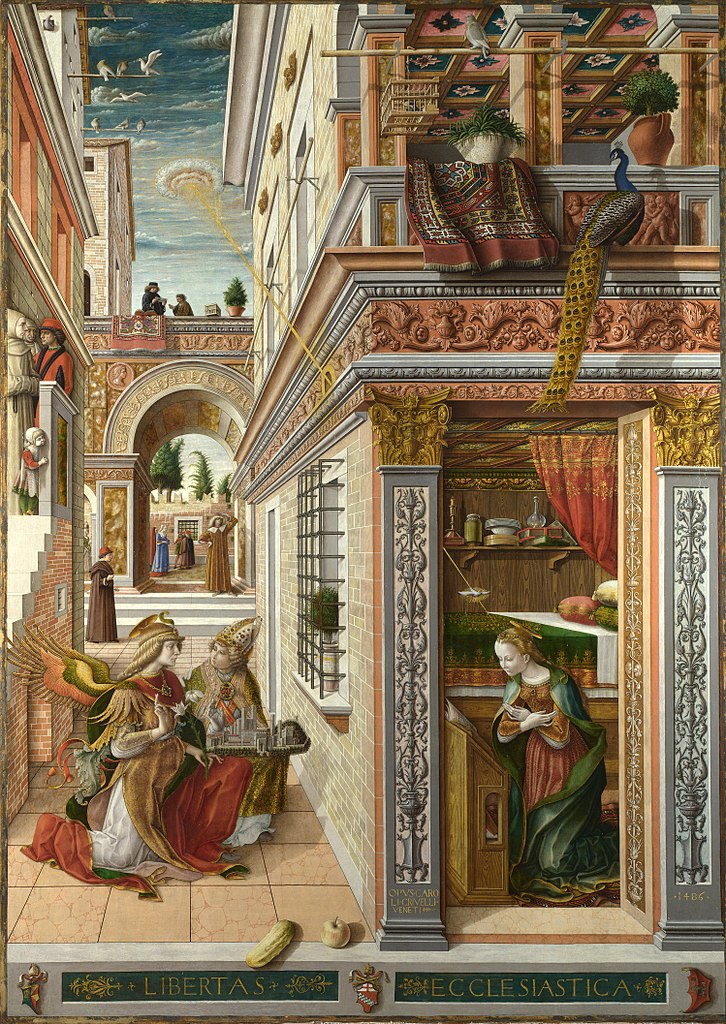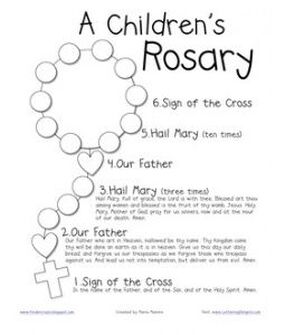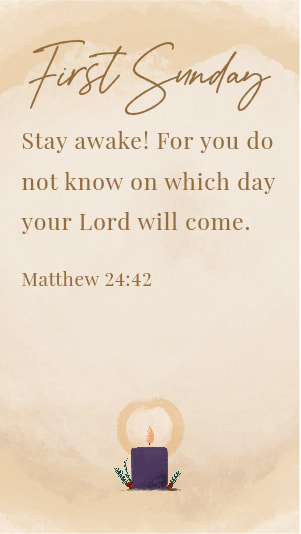|
Before beginning your prayers, take some time to look at the painting. Read its description while looking at the painting carefully. Then, while you are praying, continue to look at the painting and think about the story it tells. You may also wish to review: Look in your children's workbooks or click here to become familiar with the parts of your Rosary. Click here to understand why you shouldn't just launch into the prayers. First Decade: The AnnunciationThe word "annunciation" looks like the word "announce," and that's what happened during the annunciation to Mary. God asked Mary, through the Archangel Gabriel, to be the mother of Jesus. Probably the first thing you see when you look at this painting is the Archangel Gabriel in the bright left area and the Blessed Virgin Mary inside her bedroom on the right. There is man next to the Archangel; this is St. Emidius listening carefully to the Archangel. The artist Carlo Crivelli painted so many symbols into this picture; let's discover a few that will help us meditate on the awesomeness of this event-- and it really is 'awesome.' People had been waiting and praying for millenia that God would come and save us, giving us the opportunity to enter into Heaven and be with Him again, so we celebrate that our prayers were finally answered when we meditate on the Annunciation-- that's why it's part of the "joyful" mysteries! Can you find the beam of golden light exploding out of the heavens? Follow the beam -- where does it land? It shines upon the head of the Blessed Virgin Mary. Do you see the white dove hovering over the crown of her head? We recognize the words of the Gospel: “The Holy Spirit will come upon you, and the power of the Most High will overshadow you; and for that reason the holy Child shall be called the Son of God” (Luke 1: 35). By the way, did you know that you have memorized some Scripture passages? The words of the Hail Mary prayer are in the Bible-- look up Luke 1: 28 and Luke 1: 41! The Annunciation with St. Emidius by Carlo Crivelli (c.1486) oil on wood transferred to canvas Currently located in The National Gallery in London, England Let's look at the painting again. It's hard to miss that beautiful peacock perched on the ledge over the doorway. The peacock symbolizes Jesus -- He's right there with God listening to His Mother say her 'yes.' Even more, the peacock symbolizes the Four Last Things: death, judgment, Heaven, and Hell. How? Well, the "eyes" on the peacock's long tail feathers symbolize the "all-seeing" God, and the peacock's tough skin reminds us of Jesus' resurrection and ours. It seems random that there's a gourd and an apple just laying in the street. The artist Crivelli included this produce in a prominent place for a reason, and he included it in so many of his paintings that it has become known as Crivelli's signature motif. Let's figure out why Crivelli liked it so much: Who in the Old Testament took a piece of fruit from a tree that they weren't supposed to eat from? The apple represents Adam and Eve’s fall from grace. The Blessed Virgin Mary is called the New Eve. We experience death through Eve, but Mary's 'yes' in the Annunciation made it possible for us to experience everlasting life with God in Heaven again. The symbolism of the gourd is taken from the story of Jonah. You know the story of Jonah and the whale -- that Jonah came out alive after an experience like that is a prefigurement of Jesus' Resurrection. In Matthew 12:40, Jesus Himself draws the parallel. In our own imaginations, we can see the shape of a gourd is similar to the shape of a whale. The story of Jonah ends with him sitting under a bush (Jonah 4: 6). Although not written in English in our Scripture, the original Hebrew language tells us this plant covered with gourds. Together, the apple and the gourd tell us that, because of Mary’s 'yes,' the human race has been redeemed (saved) from the death of sin. Here's a challenge: can you find the glass vase on the shelf in Mary’s room? It's exactly above the core of her body, isn't it? Crivelli chose a glass vase on purpose: it represents the perfect purity of the sinless Virgin. In other Renaissance paintings, artists painted a ray of light passing through the vase, which causes it to magnify and shine more powerfully. That symbolizes the fullness of grace and power of the Holy Spirit passing though Mary's soul, as she herself expressed to her cousin Elizabeth, as recorded in Luke 1: 46-56. Finally, a word about the man with the Archangel Gabriel. His name is St. Emidius; notice that he's carrying a cathedral in his hands. Carlo Crivelli made this painting to decorate the Church of the Annunciation, and St. Emidius is the patron saint of Ascoli Piceno, the city in Italy where the church is located. Maybe you can visit it someday! Now, with the Annunciation in our imagination, |
| This weekend you should set up a prayer space in your home. It could be a little table off in a corner of the living room, or taking over your kitchen island, or some other place where your family and friends can see and interact with it often. Use a tablecloth, doily, or cloth napkin as your base. For Advent and Christmas, violet, rose, white, and gold are your best choices. Companies sell Advent wreaths and calendars. If you like those devotionals, use them, but you don't have to. The candles for the wreath must be 3 violet and 1 rose. Instructions for lighting the wreath every Sunday can easily be found on the Internet: violet, violet, rose, violet. Calendars or paper chains should contain good works for family members to perform, not just treats. (If you purchase anything from Amazon, please choose Holy Family as your charity when logging into Amazon Smile. Thank you!) I highly recommend you keep your family's Rosary beads and a Bible in your prayer space. This is also a great spot for your Nativity set; you ought only set up the Blessed Virgin Mary and her Guardian Angel Archangel Gabriel pieces this week. Hide all the other pieces for now; they will slowly come out. I'll let you know who comes out next week, Blessings, Mary Acevedo, Director of Religious Education |
Mary, this was wonderful! The painting “The Annunciation “ by Carlo Rivelli was amazing! All the details that you pointed out, besides many more that are in this painting are so impressionable.
It's amazing, isn't it, Vickie?!
What a beautiful way to introduce the Rosary devotion and tying it to Advent in such a meaningful way. Hope that many young people will soon discover the power of the Rosary.
Thank you, Mary! That is exactly what I was trying to do, and that is exactly what I am hoping, too!
Leave a Reply.
Upcoming Family Events
here in our program, here at our parish, and throughout our Diocese.
Categories
All
2018 2019 Program Year
2019 2020 Program Year
2020 2021 Program Year
2021 2022 Program Year
2022 2023 Program Year
2023 2024 Program Year
Confirmation
COVID 19
Lent
Reconciliation And Communion
Rosary Joyful
Rosary Sorrowful
Summer Programming
Work Of Mercy
Youth Ministries
Archives
April 2024
February 2024
October 2023
May 2023
March 2023
January 2023
September 2022
August 2022
July 2022
November 2021
March 2021
February 2021
January 2021
December 2020
November 2020
September 2020
August 2020
June 2020
May 2020
February 2020
September 2019
August 2019
June 2019
May 2019
March 2019
February 2019
January 2019
September 2018
December 2017
October 2017
September 2017
April 2017
March 2017
January 2017
October 2016
September 2016
June 2016
May 2016




 RSS Feed
RSS Feed